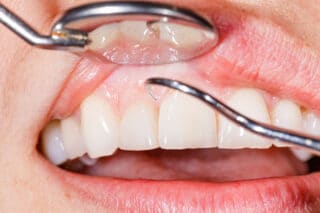
Lighthouse Family Dentistry
37 Old Solomons Island Road
Suite #1
Annapolis, MD 21401

More Dental Health Articles
The Silent Dental Disease

Bacteria from dental plaque not only attacks the soft tissue, but will eventually attack the bone causing teeth to fall out. The most common strain of bacteria in dental plaque can cause blood clots that induce heart attacks when they enter into the blood stream. Additional studies presented that dental plaque is linked to:
- A potentially fatal disease called infective endocarditis in which the sac around the heart becomes infected with bacteria
- Lung infections in people with chronic lung diseases such as chronic obstructive pulmonary disease.
- Weakened immune systems that can slow wound healing and diminish a person’s response to vaccines against hepatitis B and influenza.
- A higher risk of giving birth to premature, low birth weight infants.
Treating gum disease has become more important than ever due to these findings. Soft tissue management is a non-surgical approach to control the infection of the gums and root surfaces. There is no cure for gum disease; it can only be managed or controlled.
Your hygienist will perform the treatment, also known as scaling and root planing, to treat the infection, make recommendations to help you effectively clean your teeth daily, and guide you through the efforts to achieve and maintain optimum oral heath.
Scaling and root planing is the treatment of the diseased root surfaces below the gum line. This differs from a routine prophylaxis (cleaning) because it emphasizes cleaning below the gum line where the plaque thrives. Scaling and root planing focuses on eliminating tartar and plaque and detoxifies the root surfaces where the disease occurs before it reaches the bone where it is not reversible.
What your dentist hopes to accomplish with soft tissue management:
- Gums that do not bleed. Healthy gums do not bleed. Bleeding is a sign of infection.
- Fresher breath and taste.
- Gums that are pink, firm, and knife edge inter dental papilla.
- Reducing pocket depth.
- Control of gum disease.
Patients with gum disease are placed on a three-month re-care. This is a requirement for successful therapy. Studies have shown that within three months the plaque recycles itself.
It is very important for those who have gum disease to receive routine treatment.
Other Articles You May Find of Interest...
- Let’s Smile Dental’s 7&Up Club
- Strengthening Smiles: Understanding the Importance of Splinting Periodontally Involved Teeth
- Understanding Soft Tissue Grafting: A Key To Periodontal Health
- New Solutions for Dentures and Dental Implants
- Benefits Of Immediate Dental Implants
- Preventing Tooth Injuries During Your Child’s Active Summer
- How New Tech In the Dental Office Benefits You

















